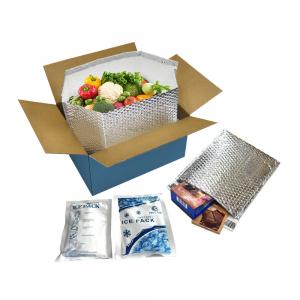
Meal kits and grocery food delivery services are a convenience that helps people add variety to their diets and prepare healthy home-cooked meals. Some research shows that meal kit services reduce food waste by providing just the right amount of ingredients needed to prepare a meal compared to shopping at the grocery store. Although the packaging used for these services plays a critical role in food safety and preservation, it also results in excessive waste. Many meal kits include more than two dozen different packages and use complicated shipping materials, such as cold packs and insulation, that are hard-to-recycle.
Here are some tips for properly dealing with meal kit packaging.
Choosing Your Service
When shopping for a meal kit or grocery delivery service, choose a company that takes steps to reduce packaging waste. Look for a service that has adopted the following best practices:
- Offers a take-back program for gel ice packs, insulating bags and envelopes, and/or other delivery materials.
- Packs hardy ingredients, such as onions and peppers, loose rather than wrapping them in plastic.
- Packs meals and groceries with materials that are readily recyclable in most curbside programs.
- Meal Kit service provides an opt-out option for items that most people already have in their kitchen, such as spices, oils, and condiments.
- Uses the How2Recycle label, a standardized labeling system with clear recycling instructions.
- Follows the tips in StopWaste’s guide: Meal Kits and Grocery Food Delivery.
Recyclable Packaging
Packaging that can be easily recycled curbside when clean/empty and dry is listed below. See what’s accepted for curbside pickup in your city.
- Cardboard boxes
- Paper and paper-based insulation
- Metal cans
- Glass bottles/jars
- Plastic bottles/jars
Gel Ice Packs
- Contact the company to see if they offer a take-back program for gel ice packs and insulating envelopes.
- Gel ice packs can be reused at home for camping or picnics.
- Find a vendor that collects them for reuse – see options here.
- If reuse isn’t an option, gel ice packs should be placed in the garbage/landfill cart.
- Do not empty gel from cold packs down the drain or toilet.
Insulation
- Clean, dry, and reuse insulation as possible.
- Offer accumulated insulation to others for free for reuse for their shipping, packing, and/or insulation needs on public forums like Craigslist, NextDoor, FreeCycle, FaceBook Buy Nothing Groups, etc.
- Plastic insulation should be placed in the garbage.
- Find out what to do with Styrofoam where you live.
- Compostable fiber and bioplastic insulation is not accepted in municipal compost systems and should be placed in the garbage.
Other Plastic Packaging
- Clean, dry and reuse film plastics like bags, wrap, and envelopes as possible and then place in the garbage or drop off at a local plastic film collection drop-off location.
- Small, lidded plastic containers are too small to be captured in the recycling process, even if they are clean and dry.
- Plastic sauce and condiment packets (sachets) belong in the trash.
Leftover Ingredients
- Label, date, and properly store any leftover dry and fresh ingredients for future use.
- See tips on proper produce and leftovers storage at StopFoodWaste.org.
Reducing Disposables When Dining Out or Taking in
- The Alameda County Department of Environmental Health, consistent with the Centers for Disease Control and Prevention, allows the use of reusable foodware when properly washed, rinsed, and sanitized. StopWaste encourages the use of reusables wherever possible to reduce cost, waste, litter, and improve diner experience.
- Learn more about Reducing Disposable Food Ware here.

